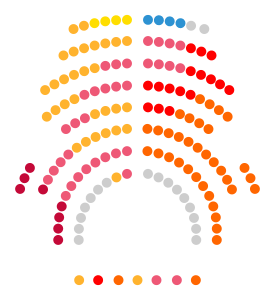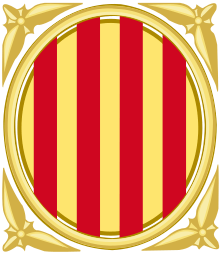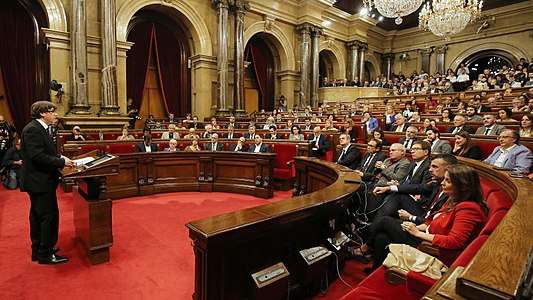Parliament of Catalonia
| Parliament of Catalonia Parlament de Catalunya Parlamento de Cataluña Parlament de Catalonha | |
|---|---|
| 12th Parliament | |
 | |
| Type | |
| Type | |
| History | |
| Founded | 1932 |
| Leadership | |
| Structure | |
| Seats | 135 |
 | |
Political groups |
Government (61) Opposition (69)
|
| Elections | |
| Party-list proportional representation | |
Last election | 21 December 2017 |
| Meeting place | |
|
| |
| Palau del Parlament de Catalunya, Parc de la Ciutadella, Barcelona, Catalonia, Spain. | |
| Website | |
| www.parlament.cat | |
 |
|---|
| This article is part of a series on the politics and government of Catalonia |
|
Statutes and constitutions
|
|
Judiciary
|
|
Public order |
|
Divisions
|
The Parliament of Catalonia (Catalan: Parlament de Catalunya, IPA: [pəɾləˈmen də kətəˈluɲə]; Spanish: Parlamento de Cataluña; Occitan: Parlament de Catalonha) is the unicameral regional legislature of Catalonia. It is formed by 135 members ("diputats"), who are elected every four years or after extraordinary dissolution, chosen by universal suffrage in lists with four constituencies, the Catalan provinces. The Parliament building is located in Ciutadella park, Barcelona, Catalonia, Spain.
The most recent parliamentary elections were held on 21 December 2017. Following the 2015 Catalan regional election and the disputed[1] October 1st independence referendum results, the Parliament of Catalonia unilaterally declared independence from Spain on 27 October 2017 with a vote of 70–10, and purported to form the Catalan Republic. The remaining 55 members abstained or boycotted the vote, disagreeing with the independence movement. In response, Spanish Prime Minister Mariano Rajoy dissolved the Parliament and called for a snap regional election.[2]
History
Catalan Courts
The first representative and legislative bodies in Catalonia were the Peace and Truce of God Assemblies (assemblees de pau i treva), of which the earliest record dates from 1027. These were originally ad hoc, local meetings convened by the clergy (Oliba, Bishop of Vic, who died in 1046, was a notable instigator) but progressively became subsumed into the court of the Counts of Barcelona. The first Catalan legal code, the Usatges de Barcelona, was promulgated by Count Ramon Berenguer I based on the decisions of these assemblies.
Although the Counts of Barcelona, had greatly extended the territory under their control, their financial and military power was quite limited, partly because of their former status as vassals of the Carolingian dynasty. Their personal resources were particularly insufficient in periods of economic crisis or military expansion, of which they were many from the twelfth to the fifteenth centuries. The need to secure troops and revenue led to the steady expansion of the royal court and a formalisation of its procedures. It came to be referred to as the Cort General de Catalunya or Corts catalanes (Catalan Courts), and was endowed with formal procedures, effectively a written constitution, by King Peter III of Aragon in 1283, making from this institution the policemaking and legislative body of the Principality of Catalonia.
The Corts Catalanes were composed of Three Estates (Tres Braços), representing the clergy, the feudal nobles and the citizens of Royal towns such as Barcelona or Girona. Inhabitants of feudal towns (such as Cardona) were not represented, except by their overlords. The main function of the Corts was legislative, either in approving laws proposed by the King Peter III of Aragon (Constitucions) or at their own initiative (capítols de cort). Although the Corts met at irregular intervals, it also formally approved the acts of the between the King and their sessions (known as pragmàtiques) and, from 1359, established a permanent delegation to oversee the Crown (the Deputation of the General, forerunner of the Generalitat de Catalunya). The Catalan Courts were abolished by the Nueva Planta decrees in 1716 after the House of Bourbon, supported by the Crown of Castille, defeated the Habsburg pretender to throne, which was backed by the remnants of the Crown of Aragon in the War of the Spanish Succession.
Modern history
There were attempts in the early 20th century to institute an autonomous system of representation for Catalonia. The Commonwealth of Catalonia (1914–25) was an assembly without legislative powers of the provincial delegations of Barcelona, Girona, Lleida and Tarragona, disbanded and outlawed by Miguel Primo de Rivera´s dictatorship in 1925.
Following an abortive declaration of the Catalan Republic on 14 April 1931, a separate Parliament of Catalonia was established under the first Statute of Autonomy approved by the Parliament of the new Spanish Republic, and was elected on 20 November 1932. This first legislature was controlled by the Republican Left of Catalonia, the winning party of the election, while the conservative Regionalist League, almost hegemonic in Catalonia during the reign of Alfonso XIII, reached the second place but far from the Republican Left.[3] The Parliament approved a large number of progressive legislation in different areas, such as health, culture and civil law, but the institution was suspended between 1934 and 1936 when the Government of Catalonia attempted to create a Catalan State after, among other reasons, a bill to change the taxing of farmers was rejected by the Constitutional Court. The unilateral declaration of independence lasted 10 hours. The Statute of Autonomy was briefly restored in February 1936 after the victory of Popular Front in the Spanish election, and abolished again by Generalissimo Francisco Franco in 1938 during the Spanish Civil War. The Parliament of Catalonia, like the rest of the institutions of the Generalitat, went to exile in 1939. After the death of Franco in 1975 and the Spanish transition to democracy, the new Statute of Autonomy of Catalonia of 1979 recognized the restoration of the Parliament. The first legislature of the current Parliament of Catalonia was elected on 20 March 1980.
On 27 October 2017, the Parliament tried to found a Catalan republic with an unilateral declaration of independence.
Functions
- To elect the President of the Generalitat de Catalunya.
- To pass the Catalan legislation in the business of its competence.
- To pass the Budget of the Autonomous Community of Catalonia.
- To control the action of the Government of Catalonia and the autonomous agencies, public companies and all other bodies answerable to it.
Gallery
- Parliament of Catalonia gallery
- Session chamber of the Palace of Parliament of Catalonia
 Catalan President Carles Puigdemont gives a speech at the Catalan Parliament on 10 October 2017
Catalan President Carles Puigdemont gives a speech at the Catalan Parliament on 10 October 2017
References
- ↑ Carranco, Rebeca (17 October 2017). "Spain's Constitutional Court strikes down Catalan referendum law". El Pais. Retrieved 17 February 2018.
- ↑ Ponce de León, Rodrigo (27 October 2017). "Rajoy cesa a Puigdemont y su Govern y convoca elecciones para el 21 de diciembre". eldiario.es (in Spanish). Retrieved 27 October 2017.
- ↑
External links
- Official website (multilingual, mostly in Catalan)
- "Parlament de Catalunya – Història" (in Catalan). Archived from the original on 22 February 2013. Retrieved 5 January 2007.